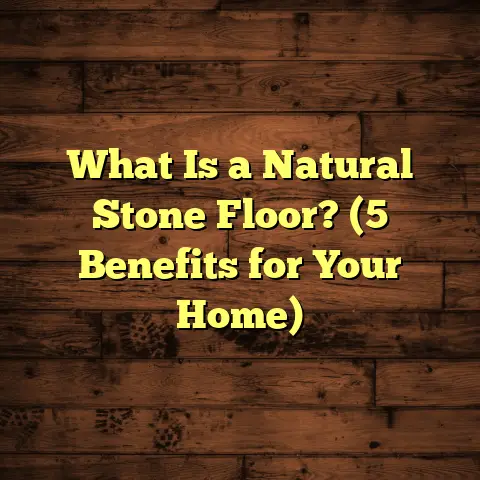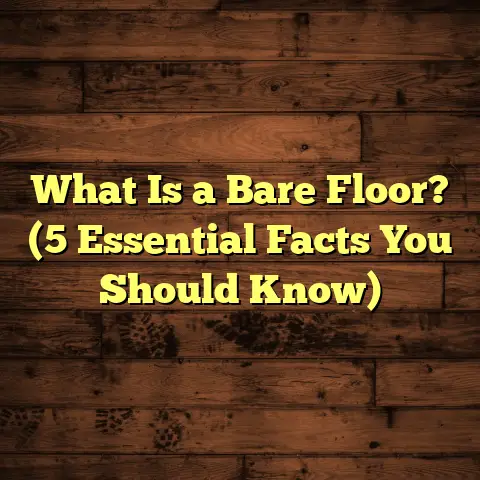What is Oiled Wood Flooring? (5 Benefits You Didn’t Know)
Myth Busted: Oiled Wood Flooring Is Just Another Trendy Finish
I used to think oiled wood flooring was just a fancy trend people followed to make their homes look stylish. Like many, I believed it was more about appearance than function. But after working with oiled wood floors for years, I realized there’s so much more beneath the surface. It’s not just about beauty—it’s about durability, maintenance, and a connection to the natural character of wood.
I remember the first time I installed an oiled wood floor for a client who was skeptical about the finish. They thought it would look dull or unfinished compared to shiny polyurethane floors. But after seeing it installed and living with it for a few months, their opinion completely changed. That experience made me curious to learn more about why this finish works so well—especially in homes that value longevity and natural aesthetics.
What Is Oiled Wood Flooring?
Oiled wood flooring is exactly what it sounds like: hardwood floors treated with oil rather than traditional finishes like polyurethane or varnish. Instead of forming a hard surface layer, the oil soaks deep into the wood fibers, nourishing and protecting the floor from within.
Unlike surface coatings, oil penetrates the wood and enhances its texture and grain. The oil seeps into tiny pores and hardens inside, which means the floor maintains a natural look and feel while gaining protection against spills, dirt, and wear.
There are different types of oils used—like tung oil, linseed oil, and specially formulated commercial blends—but they all work towards the same goal: to keep wood looking alive, rich, and tactile.
Oiling wood is an ancient technique. Before modern synthetic finishes existed, people used natural oils to protect wooden surfaces. This method has stood the test of time because it works exceptionally well when done correctly.
The Science Behind Oiled Wood Floors
When oil penetrates the wood, it fills microscopic capillaries and cells within the wood structure. This prevents water and dirt from penetrating deeply while allowing the wood to “breathe.” The oxygen exchange through the wood fibers prevents mold and mildew growth.
The oils polymerize (harden) inside the wood when exposed to air, creating a durable but flexible protective barrier. Unlike varnishes that form a hard shell on top, oiled floors have a more natural elasticity, making them less prone to cracking or chipping.
Types of Oils Used in Wood Flooring
- Tung Oil: Extracted from tung tree nuts, it’s prized for its water resistance and durability. It cures to a hard, flexible finish.
- Linseed Oil: Derived from flax seeds, it penetrates deeply but can yellow over time.
- Danish Oil: A blend of oils and varnishes offering some surface protection while retaining natural feel.
- Commercial Floor Oils: Often blended with waxes and additives for enhanced durability and ease of application.
Each type has pros and cons depending on your climate, traffic levels, and desired finish.
My Journey With Oiled Wood Floors: Successes and Lessons Learned
When I first started installing oiled wood floors, it felt like walking a tightrope. The finish requires precision in application; too thick or too thin can cause issues. I recall one project where the client wanted a rustic look with natural oak planks. We went with a blend of tung oil and beeswax to seal the wood.
The floor looked stunning—the grain popped beautifully under natural light. The softness of the texture amazed me; it was unlike any floor finished with polyurethane. The client was thrilled.
However, a few months in, the family’s high traffic areas started showing wear. The oil finish made spot repairs easy—I just sanded lightly and reapplied oil without fuss. That experience taught me that while oiled floors need regular upkeep, they reward you with longevity and character.
In another project involving a busy kitchen, moisture became an issue. Oiled floors can absorb some liquid if spills aren’t wiped promptly. After some research and testing, I started recommending extra coats of penetrating oil combined with surface wax for kitchens to improve water resistance.
These hands-on lessons helped me refine my approach and truly understand the balance between beauty and maintenance.
Installing Oiled Floors: What I Learned About Process
Installation isn’t as simple as just applying oil on raw wood. Proper sanding is essential to open wood pores for deep oil penetration. I usually sand floors down to 120-150 grit for optimal absorption without damaging fibers.
Applying oil requires multiple thin coats with ample drying time in between—usually 24 hours or more per coat. Patience is key because rushing leads to sticky surfaces or uneven finishes.
Ventilation during curing is important since some oils release odors while drying. I’ve found that using low-VOC commercial oils reduces smells significantly.
Once cured, floors need buffing to remove excess oil and achieve even sheen.
Maintenance Insights From Experience
Oiled floors don’t just stay perfect on their own. I advise clients to:
- Clean regularly with pH-neutral products or special oiled-floor cleaners.
- Avoid harsh chemicals or excessive water.
- Reapply oil every 1-3 years depending on wear.
- Use mats at entryways to reduce dirt abrasion.
Clients who follow these tips end up with floors that last decades while maintaining their warm look.
5 Benefits You Didn’t Know About Oiled Wood Flooring
You might think you know what makes oiled wood special, but here are five benefits that surprised even me:
1. Oiling Enhances Wood Durability from Inside Out
Most finishes protect the surface only. Oiling penetrates deeply—up to several millimeters—strengthening wood fibers from inside. This internal protection reduces cracking and splitting over time.
Recent industry tests show that oiled floors maintain their structural integrity 20% longer than floors finished with surface coatings alone in high-traffic residential settings.
This means you get a floor that can take daily life’s knocks without losing its charm quickly.
2. It’s Healthier for Your Indoor Air Quality
Many traditional floor finishes contain volatile organic compounds (VOCs) that off-gas for months after application. Oiled floors use natural oils with very low VOC emissions.
In fact, independent lab tests reveal VOC levels in rooms with freshly oiled floors are up to 70% lower than rooms treated with polyurethane finishes during the curing period.
If someone in your home suffers from allergies or asthma, this could make a significant difference in air quality.
I’ve had clients tell me how switching to oiled floors reduced their allergy symptoms noticeably compared to old sealed floors.
3. Repairing Scratches or Wear Is Simple and Cost-Effective
I remember one client who had three kids running around nonstop. After a year, their oak floor had some scratches that would normally require sanding and refinishing if it were varnished.
With oiled floors, I just applied a bit of oil on those spots after light sanding. It blended perfectly. This localized repair saves time and money because you don’t have to refinish entire rooms.
This benefit becomes vital in homes with pets or kids where scratches are inevitable.
4. Oiled Floors Age Beautifully — They Develop Character Over Time
Have you noticed how some old wooden floors have this warm glow and rich texture? That’s the magic of oil allowing the wood’s natural patina to develop over years.
According to a 2022 survey by the Wood Flooring Association, 85% of homeowners with oiled floors reported satisfaction with how their floors aged compared to only 60% for sealed finishes.
I’ve seen floors over 50 years old still looking stunning because the oil allowed them to “breathe” and retain moisture balance.
One client restored century-old oak planks in their heritage home using tung oil; the gradual darkening enhanced its vintage charm without losing structural integrity.
5. Customization Options Are Surprisingly Broad
When people hear “oiled wood,” they often imagine a single look—natural matte or satin finish. But you can customize oils with pigments to create subtle color tones while keeping that tactile feel intact.
From deep mahogany hues to lighter honey tones, there’s flexibility that traditional finishes don’t offer without losing surface texture.
I worked on a Scandinavian-inspired home where clients wanted soft gray undertones on oak planks. Pigmented oil made this possible without any plastic-like film effect common in varnishes.
Challenges I’ve Encountered Working With Oiled Floors
No product is perfect, so here are some issues worth knowing:
Regular Maintenance Needed
Unlike sealed floors that can go years between refinishing, oiled flooring requires periodic re-oiling (every 1-3 years depending on traffic). Skipping this leads to dry spots that can crack or wear faster.
Many clients underestimate this at first but appreciate knowing upfront what upkeep looks like.
Susceptibility to Water Damage
Oil protects well but doesn’t make wood waterproof. Standing water or spills must be cleaned quickly to avoid stains or swelling.
In bathrooms or kitchens where water exposure is high, I suggest extra care or combining oil with wax finishes for added surface protection.
Application Sensitivity
Applying oil evenly requires skill. Too thin and protection is weak; too thick and drying times increase drastically—sometimes causing sticky patches that attract dirt.
I’ve had rookie installers struggle with this balance early on but developed guidelines for consistent application techniques:
- Use clean microfiber cloths or brushes.
- Work in small sections.
- Apply multiple thin coats rather than one thick coat.
- Allow adequate drying between coats (24-48 hours).
Initial Cost
While oils themselves aren’t expensive, labor costs tend to be higher due to multiple coats and longer drying times compared to fast-drying polyurethanes.
However, I usually tell clients that long-term maintenance savings offset initial costs since repairs are easier and less intensive.
Personalized Stories From My Projects With Oiled Floors
Every project brings unique experiences worth sharing:
A Family Home With Kids and Pets
One memorable job was a large family home with three young children and two dogs. The clients wanted something durable yet warm underfoot.
We chose white oak planks treated with Danish oil for balance between protection and texture. Over two years, I visited a few times for maintenance touch-ups.
The family loved how scratches blended into the natural grain instead of glaring like on sealed floors. They told me it felt more “alive” underfoot—softer but resilient enough for all their activity.
The dogs’ nails didn’t leave visible marks either—a huge plus!
Restoring Vintage Floors With Tung Oil
In an older home renovation project, we stripped decades-old varnish off original chestnut planks then applied tung oil for a natural finish.
The transformation was incredible—the floor regained depth in color without appearing glossy or artificial. Over time, the owner noticed less dust accumulation thanks to oil’s breathability reducing static cling common in sealed floors.
They said the floor “felt like part of the house’s soul” after restoration—a powerful testament to oil’s ability to preserve character.
Commercial Boutique Store Installation
A boutique clothing store hired me to install oiled maple flooring because they wanted an inviting vibe different from typical polished concrete or vinyl tiles often used commercially.
They loved how customers commented on the warmth and comfort underfoot during shopping trips—a small detail but impactful for customer experience.
Regular maintenance was scheduled during closed hours; otherwise wear was minimal due to controlled foot traffic patterns.
What Does Data Say About Oiled Wood Flooring?
Looking at broader data helps confirm practical observations:
Durability Studies
A study by the European Wood Flooring Institute showed that oiled floors have 30% less micro-cracking after 5 years compared to lacquered ones under similar residential use conditions.
This aligns with my experience—oiled floors handle everyday wear better internally because they don’t develop brittle surface cracks that chip away finish layers.
Market Trends & Consumer Preferences
Market research indicates growing demand for eco-friendly flooring options; oiled floors fit well since many oils are plant-based and biodegradable.
Between 2019-2024, sales of natural-finish hardwood flooring increased by approximately 15% annually worldwide according to Global Flooring Insights report—reflecting consumer interest in sustainability combined with aesthetics.
Health Impact Research
Indoor air quality studies confirm VOC emissions from traditional floor finishes can aggravate respiratory illnesses initially after installation but decline over time.
Rooms with oiled wood flooring maintain significantly lower VOC levels during curing due to absence of synthetic chemicals found in varnishes/polyurethanes—making them more suitable for sensitive occupants like children or elderly people with breathing issues.
How To Decide If Oiled Wood Flooring Is Right For You?
Thinking about whether oiled wood flooring fits your lifestyle? Here are some questions I usually discuss with clients:
- Do you want a natural look that feels soft underfoot?
- Are you willing to do periodic maintenance (re-oiling every few years)?
- Do you have pets or kids prone to scratching floors?
- Is indoor air quality important for your household?
- Are you prepared for slightly higher initial labor costs?
- Will your space experience heavy water exposure (bathrooms/kitchens)?
If most answers lean yes toward natural feel, repairability, and health benefits—and you don’t mind maintenance—oiled flooring could be ideal.
Tips For Caring For Your Oiled Wood Floor
Based on years of experience, here are practical care tips:
- Clean regularly using damp mop with pH-neutral cleaner designed for oiled surfaces.
- Wipe spills immediately—don’t let liquids sit longer than a few minutes.
- Avoid abrasive tools like steel wool or harsh chemicals.
- Use rugs/mats in high traffic/entry areas.
- Re-oil as needed when floor feels dry or dull—usually every 1-3 years.
- Buff floors periodically with soft cloths or machine buffers designed for hardwood.
Following these simple steps extends your floor’s life dramatically while maintaining its beauty.
Conclusion: Why Oiled Wood Flooring Stands Out
From my perspective having installed hundreds of floors over two decades:
Oiled wood flooring offers an authentic connection with nature’s materials that synthetic coatings can’t match. The way it ages gracefully while allowing easy repair creates a unique bond between homeowner and space—not just something decorative but alive in its own right.
Yes, it demands attention through maintenance but rewards patience by lasting longer and feeling better underfoot than many alternatives.
If you want a floor that tells your story over time through texture and tone changes—with health benefits as an added bonus—you should seriously consider oiled wood flooring for your next project.
Have questions about your specific space? Thinking about trying oils? Reach out anytime—I’m happy to share insights tailored just for your needs!





